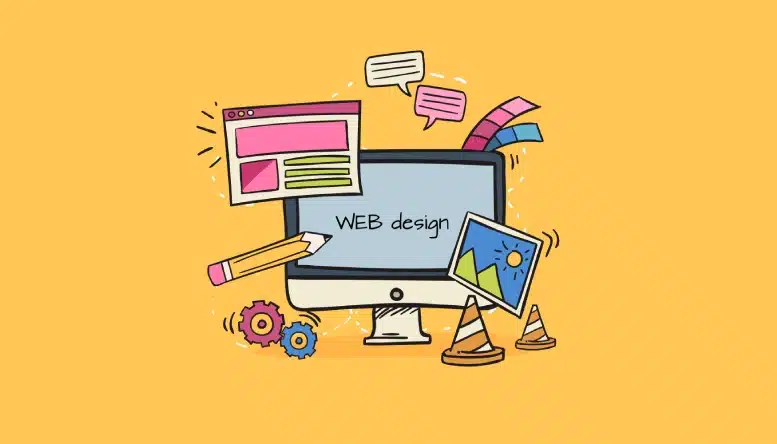The Significance of User Experience in Effective Web Design Methods
User experience (UX) offers as a foundation in effective web design methods. It forms exactly how customers connect with a site, affecting their contentment and probability of returning. A well-designed UX can improve interaction via instinctive navigation and receptive formats. Neglecting these facets might lead to frustration and boosted bounce prices. Understanding the intricacies of UX is important for designers intending to develop compelling digital experiences that reverberate with varied audiences. What aspects genuinely drive successful user involvement?
Recognizing User Experience and Its Effect On Design
Although user experience (UX) is often regarded as a simple element of web design, it fundamentally shapes exactly how customers communicate with a site. UX encompasses all facets of the user's interaction, including use, access, and total satisfaction. A positive UX cultivates involvement, motivating users to explore the website and return in the future. Alternatively, a negative experience can bring about frustration, leading to high bounce rates and lost possibilities for conversion.
Design aspects like navigation, web content, and format organization play critical roles in forming this experience. Efficient UX layout expects user requirements and preferences, making certain that information is visually enticing and quickly obtainable. In addition, comprehending user behavior through analytics can supply beneficial understandings, educating layout choices that enhance usability. Eventually, an extensive understanding of UX allows designers to produce internet sites that not only attract customers yet likewise promote meaningful interactions that align with organization goals and user assumptions.
Trick Principles of Effective User Experience
Reliable user experience depends upon numerous vital concepts that boost site functionality and interaction. Instinctive navigating style, receptive layout essentials, and the value of aesthetic power structure are vital components that add to a seamless interaction in between users and web material. Understanding these concepts enables designers to create even more straightforward and easily accessible digital environments.
Intuitive Navigating Design
User-friendly navigation design offers as an important portal to their total experience when users come across a web site. Reliable navigation allows users to easily locate the info they look for, improving their interaction with the site. Trick principles include clear labeling, logical company, and consistent placement of navigation aspects. Labels must be simple, permitting individuals to anticipate the content they will certainly locate. A well-structured pecking order assists users comprehend the connection between various areas, guiding them with the internet site effortlessly. Additionally, responsive menus and quickly available web links add to a fluid experience across tools. By prioritizing intuitive navigation, developers can considerably reduce user stress and boost engagement, inevitably promoting a positive assumption of the site and its material.
Responsive Format Basics
A well-structured navigating system naturally causes the need for a receptive design, which is important in today's varied electronic landscape. A responsive design warranties that websites feature seamlessly throughout different gadgets, including tablet computers, desktops, and smart devices. This versatility improves user experience by permitting material to be aesthetically coherent and easily available, despite screen size. Key concepts of receptive design consist of fluid grids, versatile images, and media questions, which facilitate optimal viewing. In addition, focusing on touch-friendly aspects enhances communication on mobile phones. By executing a receptive format, developers can accommodate individuals' needs, lessen bounce prices, and rise involvement. Inevitably, a well-executed receptive design cultivates a positive user experience, urging visitors to check out the website even more.
Aesthetic Hierarchy Significance
Aesthetic pecking order plays a vital duty in directing users with a website, making certain that critical details records their interest. By strategically utilizing dimension, comparison, color, and spacing, developers can produce a clear pathway for customers to adhere to. Larger components typically draw the eye, indicating their relevance, while contrasting colors can highlight telephone calls to activity. Additionally, consistent alignment and grouping of relevant content enhance comprehension, making navigation user-friendly. Effective use of visual power structure not just improves usability but also supports the general visual of the site, fostering a positive user experience. When individuals can easily identify one of the most critical details, they are more probable to involve with the material, bring about raised contentment and communication with the site.
The Function of Use in Web Design
Functionality plays a vital function in web design, especially with navigating simpleness and adherence to accessibility criteria. Effective navigating improves user contentment by enabling site visitors to locate details promptly and intuitively. Meeting accessibility criteria assures that all customers, no matter of their capacities, can successfully interact with the web site.
Navigation Simpleness
Simplicity in navigating stands as a cornerstone of reliable web design, considerably affecting user experience. A streamlined navigating system enables customers to discover details promptly and intuitively, minimizing stress and improving complete satisfaction. Clear labeling and rational structure are crucial components, guiding users effortlessly through the site. Repetitive links or extremely complicated food selections can disorient customers, resulting in raised bounce rates. Additionally, mobile responsiveness must be considered, guaranteeing navigation continues to be straightforward across devices. Focusing on necessary pages and decreasing clutter additionally sustains user engagement. Reliable navigating not just cultivates a favorable experience but likewise urges individuals to discover the site better, ultimately leading to higher conversion rates. Hereof, navigating simplicity works as a vital check that consider the general efficiency of web design techniques.
Ease of access Requirements
User engagement is considerably enhanced when sites stick to accessibility criteria, guaranteeing that all users, regardless of their capacities, can navigate and connect properly. Compliance with these requirements not only expands the target market however additionally boosts general user contentment. Obtainable layout integrates features such as text options for images, keyboard navigating, and enough shade contrast, which assist in usage by people with impairments. Furthermore, implementing these standards can positively impact search engine optimization (SEO) by improving site framework and quality. As web design advances, prioritizing accessibility ends up being necessary in fostering an inclusive digital environment. By welcoming these standards, developers add to a much more fair net, eventually driving user commitment and engagement.
Value of Responsive Layout for User Engagement
As customers increasingly access web sites with a variety of tools, the significance of responsive layout becomes paramount for engaging customers properly. Responsive style warranties that a web site adjusts effortlessly to various screen dimensions, offering a perfect viewing experience regardless of the tool utilized. This versatility improves user engagement by helping with easier navigation and communication with content.
When individuals come across a website that is receptive, they are extra most likely to stay much longer, check out even more, and return in the future. A properly designed responsive format reduces the irritation typically connected with zooming and scrolling on smaller sized displays, thereby minimizing bounce rates. In addition, receptive layout can positively impact online search engine positions, as internet search engine focus on mobile-friendly internet sites. In today's digital landscape, where mobile usage proceeds to increase, executing receptive design is not simply beneficial, but essential for preserving user involvement and assuring a favorable experience throughout all devices.
Enhancing Load Times for Better User Fulfillment

To enhance tons times, web designers need to prioritize enhancing images, leveraging internet browser caching, and reducing HTTP requests. Additionally, utilizing Material Distribution Networks (CDNs) can speed up content distribution by dispersing it across different geographical locations. Streamlining code, such as pressing CSS and JavaScript data, further adds to much faster filling speeds.
Eventually, a commitment to improving load times not check this site out only improves user fulfillment but additionally reinforces brand name loyalty and improves the likelihood of repeat gos to. A swift, smooth experience is essential for preserving customers and cultivating positive interactions.
The Impact of Visual Power Structure on User Communication
Aesthetic hierarchy works as an essential element in leading user interaction on an internet site. By arranging content in a manner that focuses on info visually, designers can influence just how users browse and involve with a website. This hierarchy is established via numerous layout methods, consisting of size, comparison, spacing, and color. Larger typefaces or vibrant shades draw focus to important elements, such as telephone calls to activity or headlines, while restrained shades and smaller sized font styles can show secondary information.
Effective visual hierarchy assists individuals swiftly identify what is crucial, decreasing cognitive tons and boosting functionality. It permits user-friendly navigation, making it easier for individuals to discover what they require without frustration. As users communicate with an internet site, a well-structured aesthetic hierarchy fosters an extra enjoyable experience, ultimately leading to greater involvement and conversion prices. Designers should focus on these concepts to develop a effective and user-centered web atmosphere.
Measuring User Experience: Strategies and tools

Frequently Asked Concerns
How Can I Improve My Site's User Experience on a Spending plan?
To boost a site's user experience on a budget, one can maximize page load rate, simplify navigating, apply responsive layout, enhance content quality, and gather user comments for continual refinements, ensuring a gratifying visitor experience.
What Prevail User Experience Mistakes to Stay Clear Of in Web Design?
Typical user experience mistakes in web design consist of messy layouts, bad navigating, slow-moving filling times, absence of mobile responsiveness, ignoring access, inconsistent branding, and failing to focus on user feedback - Web Design Agency. Each can substantially impede total website efficiency
Just how Frequently Should I Update My Internet Site for Better User Experience?
Internet sites should be upgraded frequently, ideally every few months, to keep optimal user experience. Constant updates assist address functionality problems, rejuvenate material, and adapt to transforming user demands, ensuring the site continues to be pertinent and interesting.

Can User Experience Impact SEO Rankings on My Website?
User experience can considerably influence SEO positions, as search engines prioritize websites that supply seamless navigation, fast filling times, and appealing material. A positive user experience can bring about lower bounce prices and greater search visibility.
What Role Does Accessibility Play in User Experience Layout?
Access plays a vital function in user experience style by making sure that all individuals, no matter capabilities, can navigate and connect with a website effectively. This inclusivity enhances general satisfaction and involvement amongst diverse users.
User experience (UX) is commonly perceived as a mere element of web layout, it basically forms how customers connect with a site. User involvement is significantly boosted when sites stick to availability standards, making certain that all customers, regardless of their abilities, can navigate and communicate effectively. Determining user experience (UX) is essential for recognizing just how successfully a website satisfies the needs of its users. Additionally, use screening, where real individuals navigate the site while viewers keep in mind problems, uses straight feedback on user experience. Usual user experience blunders in internet design consist of chaotic layouts, inadequate navigating, sluggish packing times, lack of mobile responsiveness, neglecting accessibility, irregular branding, and falling short to prioritize user feedback.